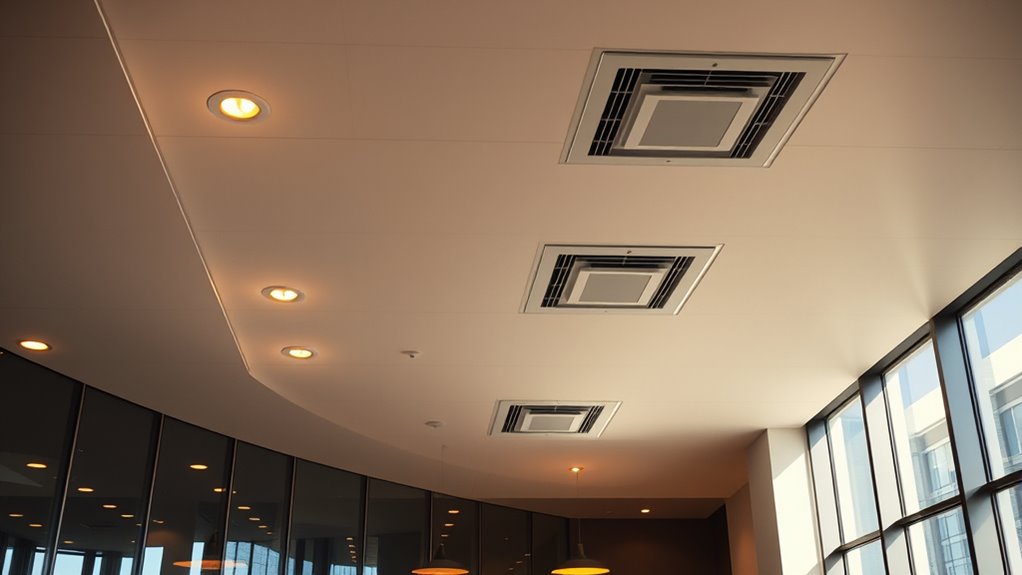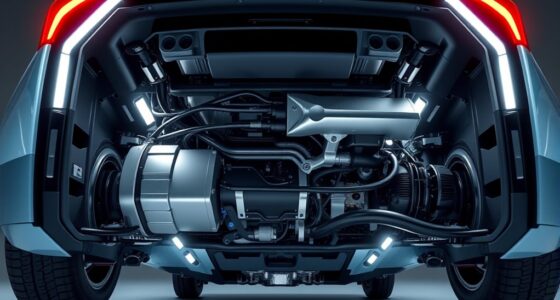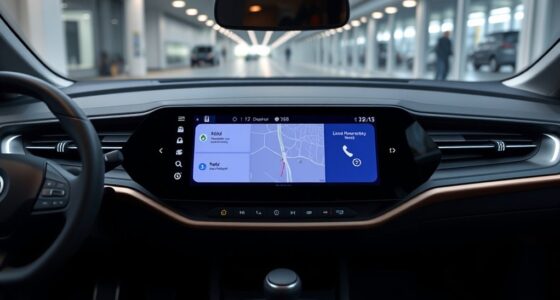Auxiliary systems like HVAC and lighting considerably impact your building’s energy consumption. They often use the most energy, especially if not managed efficiently. You can reduce this by using building automation to control and optimize these systems based on occupancy, weather, or time. Automated adjustments, sensors, and scheduling help prevent unnecessary use, saving energy and costs. Keep exploring to discover how smart management can make these systems even more efficient in your space.
Key Takeaways
- Auxiliary systems like HVAC and lighting significantly contribute to overall building energy consumption.
- Automating these systems helps optimize their operation, reducing unnecessary energy use.
- Precise control of HVAC and lighting improves occupant comfort while minimizing waste.
- Energy-efficient lighting and HVAC management lower operational costs and environmental impact.
- Data analysis of auxiliary system performance identifies opportunities for further energy savings.

Auxiliary systems play a essential role in the overall energy consumption of various facilities and equipment. Among these, HVAC and lighting systems stand out as major contributors, often accounting for a significant portion of energy use. Understanding how these systems operate and how you can optimize them is critical for reducing energy costs and improving efficiency. Building automation plays a key role here, allowing you to monitor, control, and fine-tune these systems to maximize their performance while minimizing waste.
Optimizing HVAC and lighting through building automation reduces energy costs and enhances efficiency.
When you incorporate building automation, you gain the ability to automate lighting and HVAC operations based on occupancy, time of day, or external weather conditions. This means lights won’t stay on unnecessarily when rooms are empty, and heating or cooling won’t run when it’s not needed. By implementing smart sensors and control systems, you can adjust lighting levels and temperature settings in real time, ensuring the environment remains comfortable without overusing energy. System optimization becomes a continuous process, where data collected from automation tools helps identify inefficiencies and areas for improvement.
In terms of HVAC, automation allows you to manage airflow, temperature, and humidity more precisely. Instead of running the system at full capacity all day, automation enables you to cycle equipment on and off as required, reducing energy draw without compromising comfort. For example, during off-peak hours, you can lower heating or cooling setpoints, saving energy when demand is lower. Regular maintenance, combined with automation, keeps systems running efficiently by preventing issues like leaks or sensor malfunctions, which can otherwise cause energy waste.
Lighting systems benefit immensely from automation as well. Installing motion sensors and programmable lighting controls ensures lights are only on when needed, preventing unnecessary energy expenditure. Dimming capabilities can also be integrated, allowing you to adjust lighting levels based on natural daylight availability. This not only saves energy but also enhances occupant comfort. When combined with building automation, these lighting controls can respond dynamically to occupancy patterns and daylight availability, further optimizing energy use.
Additionally, understanding the energy consumption patterns of auxiliary systems through data analysis can help you develop targeted strategies for efficiency improvements. Ultimately, the key to minimizing energy consumption from auxiliary systems lies in continuous system optimization. Regularly reviewing data from building automation platforms helps you identify patterns and pinpoint inefficiencies. Small adjustments, like fine-tuning schedules or upgrading outdated components, can lead to substantial savings over time. By actively managing and optimizing your lighting and HVAC systems, you create a more energy-efficient environment that benefits both your operational costs and the environment.
Frequently Asked Questions
How Do Auxiliary Systems Impact Overall Energy Efficiency?
Auxiliary systems impact your overall energy efficiency by directly affecting occupant comfort and system integration. When designed well, these systems optimize energy use, reducing waste while maintaining a comfortable environment. You can improve efficiency by ensuring HVAC and lighting work seamlessly together, adjusting based on occupancy and natural conditions. This integration helps save energy, lowers costs, and creates a more comfortable space for everyone.
What Are the Latest Innovations in HVAC and Lighting Technology?
You’ll find that the latest HVAC and lighting innovations include smart sensors and renewable integration, making systems more efficient. Smart sensors adjust energy use dynamically, reducing waste, while renewable integration allows your building to harness solar or wind power. These advancements aren’t just tech trends—they’re practical solutions that cut costs and lower your carbon footprint, proving you don’t have to sacrifice comfort for sustainability.
How Can Building Design Optimize Auxiliary System Energy Use?
You can optimize auxiliary system energy use by implementing zoning strategies that target specific areas for heating, cooling, and lighting, reducing unnecessary energy expenditure. Additionally, leverage daylight harvesting to maximize natural light, decreasing reliance on artificial lighting. These approaches allow you to fine-tune system operation, improve energy efficiency, and lower costs, all while maintaining occupant comfort and enhancing your building’s sustainability.
What Maintenance Practices Enhance Auxiliary System Energy Performance?
Think of your auxiliary systems as the heart of your building—keeping everything running smoothly. You can boost their performance through regular preventive maintenance and energy audits, catching issues before they become costly. Clean filters, inspect controls, and calibrate sensors frequently. These practices guarantee your HVAC and lighting systems operate efficiently, saving energy and extending their lifespan. Staying proactive keeps your building healthy and energy-smart.
Are There Government Incentives for Upgrading Auxiliary Systems?
Yes, there are government incentives for upgrading auxiliary systems through renewable incentives and retrofit programs. These initiatives aim to encourage energy-efficient improvements, helping you reduce costs and environmental impact. By taking advantage of these incentives, you can offset upgrade expenses and make your building more sustainable. Check with local and federal agencies to find available programs, application details, and eligibility requirements, so you can maximize your benefits.
Conclusion
In wrapping up, remember that auxiliary systems like HVAC and lighting considerably spike your energy consumption. By being mindful of their maintenance, minimizing unnecessary use, and optimizing settings, you can cut costs and conserve resources. Small steps make a substantial difference—so stay savvy, switch smart, and streamline systems. Your efforts not only save energy but also support sustainability, showcasing your commitment to a cleaner, greener future.









